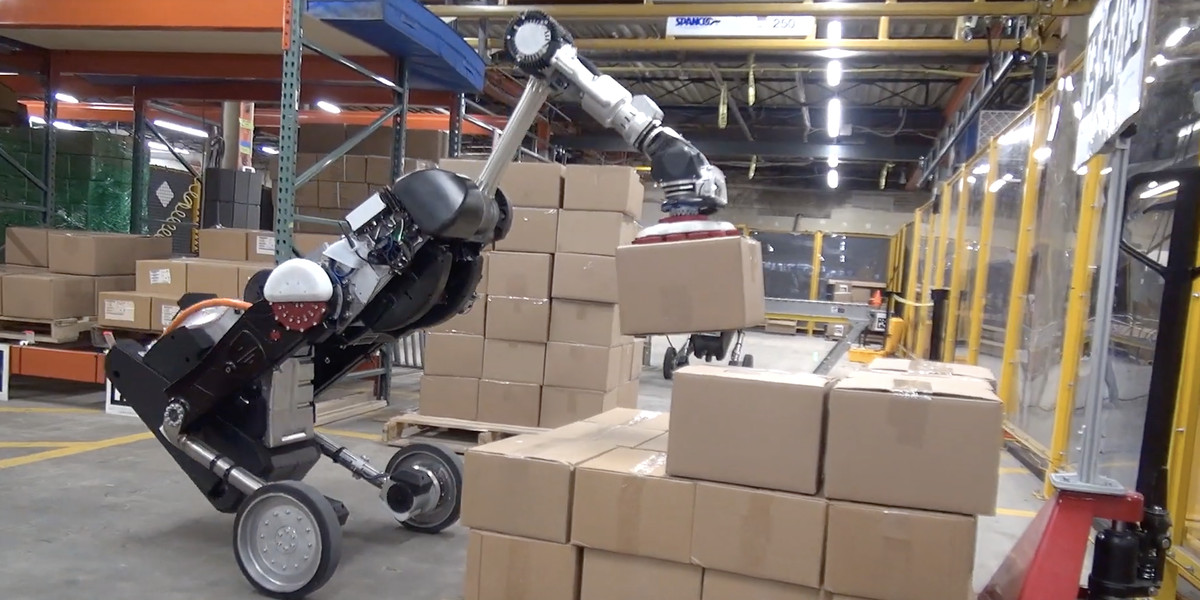Boston Dynamics buys a better brain for its robots

It is famous for making acrobatic, eerily lifelike, and somewhat accident-prone robots. Now Boston Dynamics is buying technology that could give its creations the brains they need to navigate the real world.
The company announced today that it is acquiring California-based startup Kinema Systems, which makes computer-vision and machine-learning systems for warehouse robots. The acquisition sees Boston Dynamics move into commercial sales for the first time—until now it has only sold technology to researchers—as well as establishing an outpost on the West Coast.
Kinema sells its technology to companies to help them move boxes that arrive in bulk at warehouses and factories. Shifting goods from a pallet and into storage is a complicated challenge for robot workers because boxes may be of different sizes, covered in stickers, and stacked irregularly. Worse still, the lighting may vary significantly from one installation to another, making it hard to comprehend the task.
Kinema addresses this problem using a combination of conventional cameras, 2D and 3D computer-vision algorithms, and machine learning. Its systems allow a robot to figure out for itself where one box ends and another begins (see “Self-taught robot is ready to seize a warehouse job”).
Boston Dynamics recently revealed its latest robot, a wheeled platform called Handle, which was shown rolling through a warehouse and moving boxes between shelves with a suction system.
Marc Raibert, the company’s founder and the inventor of the dynamic balancing technology that underpins all Boston Dynamics robots, says Kinema’s technology and expertise could prove crucial to making his machines more practical. Today the company’s robots, most of which have two or four legs, are brilliant at rebalancing themselves. They rapidly reposition their legs in response to a slip or a nudge, which lets them walk on even treacherous terrain such as ice without falling over. But they remain very expensive, have little ability to navigate, and mostly rely on human operators for guidance.
“All our robots need better vision,” Raibert told MIT Technology Review. “We’ve been hiring people, but buying this company is another way to get people.”
Raibert says his team was impressed with the way Kinema’s system worked in different conditions. And Kinema’s technology has potential applications outside the warehouse, such as enabling a robot to see what it needs to move through other environments.
Boston Dynamics will continue selling the platform and technology currently offered by Kinema, he says, while trying to integrate it into systems like Handle. Raibert believes this process, which could help Handle navigate unfamiliar warehouses for itself, should take around a year.
Raibert pioneered the concept of dynamic balancing in machines, leading influential research labs at both Carnegie Mellon and MIT. His company worked largely in secrecy for many years and was mostly funded by the US Defense Department.
In 2013, Boston Dynamics was one of several robotics companies acquired by Google in a sudden spending spree before being sold to the Japanese conglomerate SoftBank in 2017. The company’s robots played a prominent role in a DARPA-sponsored robotics competition held from 2012 to 2015.
Deep Dive
Artificial intelligence
Large language models can do jaw-dropping things. But nobody knows exactly why.
And that's a problem. Figuring it out is one of the biggest scientific puzzles of our time and a crucial step towards controlling more powerful future models.
Google DeepMind’s new generative model makes Super Mario–like games from scratch
Genie learns how to control games by watching hours and hours of video. It could help train next-gen robots too.
What’s next for generative video
OpenAI's Sora has raised the bar for AI moviemaking. Here are four things to bear in mind as we wrap our heads around what's coming.
Stay connected
Get the latest updates from
MIT Technology Review
Discover special offers, top stories, upcoming events, and more.